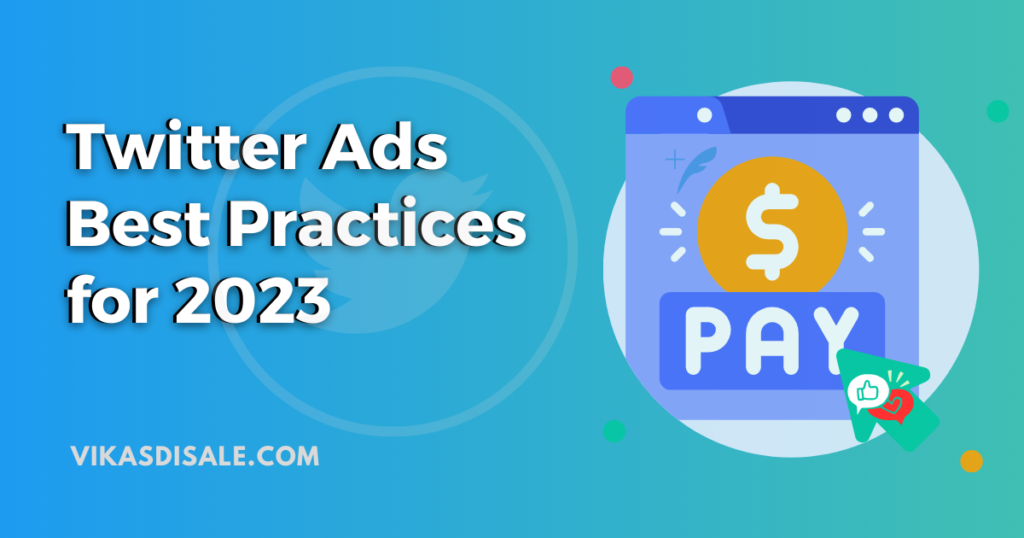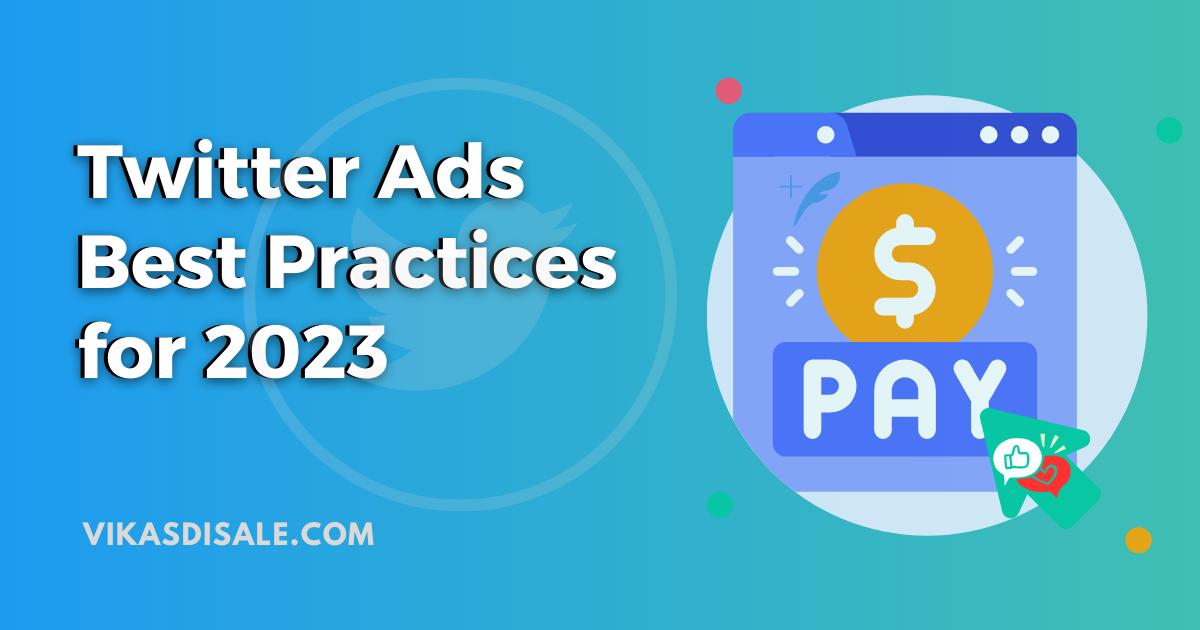
In today’s digital landscape, Twitter has become a powerful platform for businesses to reach their target audience and drive engagement. Twitter Ads is an advertising platform provided by Twitter that allows businesses to reach and engage with their target audience on the popular social media platform, driving brand awareness, website traffic, and conversions. Twitter has over 368 million monthly active users out of them 206 million are monetizable daily active users.
With various targeting options and ad formats, Twitter Ads offers businesses an effective way to promote their products or services and achieve their marketing goals. These Twitter Ads Best Practices will help you to boost your Brand.
Why Use Twitter Ads?
- The potential to reach millions of users: Harnessing the massive user base of Twitter to expand your brand’s reach.
- Objective-based ad campaigns: Define clear objectives and leverage Twitter’s ad formats to achieve specific goals.
- Robust targeting capabilities: Utilize Twitter’s advanced targeting options to reach your ideal audience.
- Rise in Twitter ad engagement: Explore the growing engagement rates on Twitter and capitalize on the platform’s active user base.
Types of Twitter Ads
Twitter offers several types of advertising options to businesses and individuals looking to promote their products, services, or messages.
Here are the main types of Twitter ads:
1. Promoted Ads:
Promoted Ads on Twitter allow you to increase the visibility of your tweets by reaching a larger audience beyond your existing followers. By promoting your tweets, you can extend their reach, increase engagement, and drive traffic to your website or other desired destinations.
This ad format helps you amplify your message and increase brand exposure.
2. Follower Ads:
Follower Ads enable you to grow your follower base on Twitter by promoting your Twitter account. These ads are displayed to targeted users who are likely to be interested in your content or industry. By encouraging users to follow your account, you can expand your reach, increase your audience, and build a community of engaged followers.
3. Twitter Amplify:
Twitter Amplify is a program that allows brands to partner with content creators, such as publishers, influencers, and broadcasters, to deliver branded video content to a wider audience.
Through these partnerships, brands can leverage the reach and influence of content creators to amplify their message and connect with a larger and more relevant audience.
4. Twitter Takeover:
Twitter Takeover ads enable brands to prominently feature their ads within trending topics and conversations on the platform. This ad format allows you to dominate a specific conversation or event by displaying your ads at the top of the timeline or search results, ensuring maximum visibility and engagement.
Twitter Takeover ads are a powerful way to capture the attention of users during highly relevant and trending discussions.
5. Dynamic Product Ads (DPA):
Dynamic Product Ads on Twitter allow you to showcase personalized product ads based on user interests and browsing behavior. By leveraging user data, such as their previous interactions with your website or app, you can dynamically generate and display ads that feature products or services they are likely to be interested in.
This ad format helps you deliver highly relevant and tailored advertisements to potential customers, increasing the chances of conversion.
6. Collection Ads:
Collection Ads on Twitter present a curated collection of products within a single ad unit, enhancing the shopping experience for users. These ads feature a primary image or video along with several accompanying product images, allowing users to explore and interact with the showcased products directly within the ad.
Collection Ads are designed to drive engagement, increase click-through rates, and boost conversions by providing a seamless and immersive shopping experience.
Overall, these Twitter ad types offer businesses a range of options to promote their content, expand their reach, grow their follower base, deliver branded video content, dominate conversations, showcase personalized product ads, and provide an enhanced shopping experience for users.
How Much Do Twitter Ads Cost?
The cost of Twitter ads can vary depending on several factors, including your advertising objectives, targeting options, ad format, bidding strategy, competition, and the overall effectiveness of your campaign.
Twitter offers various pricing models for ads, including cost-per-engagement (CPE), cost-per-click (CPC), and cost-per-thousand-impressions (CPM). With CPE, you pay when users engage with your ad (e.g., retweets, likes, replies).
The actual cost per ad engagement, click, or impression can range widely depending on factors such as your target audience, ad quality, ad relevance, ad performance, and overall demand for advertising on the platform..
To determine the cost of Twitter ads for your specific campaign, it’s recommended to set a budget and monitor the performance of your ads closely. Twitter provides advertisers with campaign analytics and reporting tools to track key metrics and optimize their campaigns for better results.
How to Set Up a Twitter Ad Campaign
1. Choose Your Ad Objective:
Defining a clear objective is the foundation of any successful Twitter ad campaign. Start by identifying your primary goal, such as increasing brand awareness, driving website traffic, generating leads, or boosting conversions.
Twitter offers various ad objectives to align with your specific goal. Select the objective that best fits your campaign’s purpose to ensure optimal ad delivery and measurement.
2. Create Your Ad:
Once you’ve determined your ad objective, it’s time to create compelling ad content that resonates with your target audience. Consider the following elements:
Ad Copy:
Craft concise, engaging, and action-oriented ad copy. Highlight the unique selling points of your product or service and emphasize the benefits it offers to users. Experiment with different headlines and add descriptions to find the most effective combination.
Visuals:
Choose visually appealing images or videos that capture attention and align with your brand identity. Optimize your visuals for mobile viewing, as the majority of Twitter users access the platform via mobile devices. Use vibrant colors, clean design, and high-resolution visuals to make your ads stand out.
Call to Action (CTA):
Include a clear and compelling CTA that prompts users to take the desired action. Use action-oriented language and specific instructions, such as “Shop now,” “Sign up today,” or “Learn more.” A strong CTA can significantly impact your campaign’s success.
3. Set Your Budget and Schedule:
To ensure effective budget management and campaign control, follow these steps:
Budget Allocation:
Determine your advertising budget based on your campaign objectives and overall marketing strategy. Consider factors such as the duration of your campaign, your target audience’s size, and the competitiveness of your industry.
Bid Strategy:
Decide on your bid strategy, such as cost per engagement (CPE), cost per click (CPC), or cost per impression (CPM). Research industry benchmarks and experiment with different bidding strategies to optimize your ad spend.
Campaign Schedule:
Define the start and end dates of your campaign, considering factors such as seasonal trends, product launches, or specific promotional periods. Align your campaign schedule with your overall marketing calendar to ensure maximum impact.
4. Customize Your Ad Delivery:
Twitter provides robust targeting capabilities to help you reach your desired audience effectively. Customize your ad delivery by considering the following factors:
Targeting Options:
Utilize Twitter targeting options to refine your audience based on demographics, interests, behaviors, and keywords. Consider factors such as location, language, gender, device type, and specific interests relevant to your target market.
Lookalike Audiences:
Create lookalike audiences based on your existing customer data or website visitors. Twitter’s Audience Manager allows you to target users who share similar characteristics and behaviors to your existing customer base.
Tailored Audiences:
Leverage Twitter’s tailored audiences feature to target users who have already shown interest in your brand. This includes remarketing to website visitors or targeting your existing customer email list.
5. Learn from Your Organic Performance:
Your organic Twitter activity can provide valuable insights to improve your ad campaigns. Analyze your top-performing organic tweets, identify the type of content that resonates with your audience, and leverage those insights in your ad copy and visuals.
Pay attention to engagement metrics, such as likes, retweets, and comments, to gauge the content’s effectiveness and adapt your ad strategy accordingly.
6. Test and Optimize:
To achieve optimal results with your Twitter ad campaigns, it’s essential to continuously test and optimize various elements. Experiment with different ad formats, headlines, visuals, CTAs, and targeting options to identify what resonates best with your audience.
A/B testing allows you to compare the performance of different ad variations and make data-driven decisions. Continually monitor your campaign’s performance, analyze metrics, and make adjustments based on the insights gained to optimize your ad campaigns.
Conclusion:
By understanding the significance of Twitter ads in visual and discovery-based marketing strategies, exploring different ad types, setting up effective campaigns, and implementing valuable tips, you are well-equipped to create successful Twitter ad campaigns. Remember, Twitter is a dynamic platform, so stay updated with new features and trends to continue optimizing your ad performance.
Vikas Disale is Digital Marketer and practicing SEO, Social Media, Paid Ads since 2011. Vikas like to share his knowledge via Podcast, YouTube videos.
